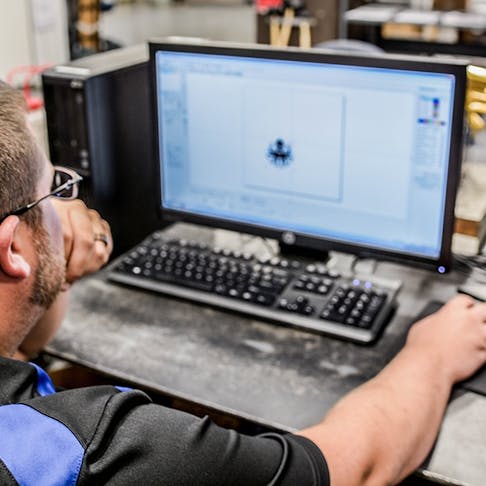The Pros and Cons of Online Manufacturing
There are so many benefits of online manufacturing procurement that highlighting a handful seems unfair. That being said, there are some positives that rise to the top faster than others — especially when you look at the traditional practices and processes that still hold sway in U.S. manufacturing.

Online manufacturing. Even a decade ago, those two words would have only managed to be grouped together in a bizarre game of Boggle. Effectively landlocked and siloed in tens of thousands of different shops across the country, CNC mills, lathes, EDMs, plasma cutters, 3D printers, and the rest of their computer numerical controlled ilk are some of the most technologically impressive machines of the 20th and 21st centuries. Still, the idea that someone might want to connect them — and the machinists at their helms — via the internet to anything else is a new one.
Tech and those who traffic in it, however, don’t balk long at tackling and making real a new idea. Given the mountain of tried-and-true processes and practices set in stone in the business of procuring CNC machined parts, the only way subtractive manufacturing was ever going to find itself transformed into a reliable internet machine shop was if the internet could somehow do the heavy lifting.
It was so unlikely it took the technological equivalent of an eon before anybody even thought of it. Then all of a sudden cloud computing put the internet everywhere for almost everybody, and voila! Manufacturers, from OEMs to small businesses, could now get CNC machined parts with little more than a credit card and a WiFi signal.
It's Mostly Silver Lining
When it comes to cloud computing, it’s hard to overstate the positives for business. Work can happen faster and in decentralized locations without any lag or communication woes. Pricing vendors, reaching out to partners, even making fast use of a constantly improving, AI-fueled translation service to suss out a competitor’s site or respond to a customer tweet can all happen now and without substantial IT investment in servers, staff and software. The cloud has made the ever-expanding offerings of advancing technology easy to access, easy to use and easy to profit from.
It’s a necessary tool given today’s marketplace, too. That consumers are connected to the internet almost constantly isn’t hyperbole; it’s reality, and it’s made possible by the cloud and a zillion portable, connected devices. Whatever it is you make, you can bet the expectations your customers harbor about getting it and using it have been honed in the soft, easy cushion of the always-on cloud. They want whatever you’ve designed, machined, assembled and marketed to them at the same instant the thought enters their minds via their screens, and they want it in their favorite color.
In a nutshell: Time isn’t what it used to be. The slow, methodical process by which manufacturers have long procured parts has become too cumbersome to survive much longer. The time-wasting crush of the RFQ process alone can bring a product launch to its knees. You’re already making use of cloud-based services across other elements of your business, from the ERP that automates mundane but essential operations to the cloud-based CAD programs like Autodesk’s 360 that keep your design and engineering teams tight. What’s the holdup on transitioning to using an online CNC milling machine?
Yes, conducting business in the cloud is not without its challenges — security and privacy come most readily to mind — but by and large, most manufacturers have already put some of their eggs in its basket. If you’re one of them, then you already know the cloud can yield impressive productivity gains. Why not turn it up to 11 with your procurement, too?
It’s time to take a measured look. Here they are, some of the pros and the one, lone con of online manufacturing.
The Pros
Where, oh where, do we start? There are so many benefits of online manufacturing procurement that highlighting a handful seems unfair. That being said, there are some positives that rise to the top faster than others — especially when you look at the traditional practices and processes that still hold sway in U.S. manufacturing.
You Can Skip the RFQ
One of the primary benefits of online CNC milling and lathing is the amount of time you’ll save — not in the actual machining itself, that just takes the time it takes — but in the processes and protocols that precede getting around to machining at all. Chief among these is the time-waster known as the Request For Quote (RFQ). An often slow, laborious slog where quotes are sourced from a variety of suppliers regarding how much it will cost to machine a particular part or batch of parts, it’s a process that results in such a disparity of prices over such an unpredictable amount of time, that it’s hard to believe it’s still used at all.
Imagine: Instead of sending out RFQs via fax or email and waiting sometimes weeks or even months for them to come back, you could just upload a part to the internet and receive a data-driven price. Because a true online CNC machining source will be driven by advanced digital technologies, the data employed in pricing will ensure the price you pay is a fair one. This benefit of a fast, fair price is one of the hallmarks of a great internet machine shop, and it removes any reason to waste time sourcing quotes at all.
Your Supply Chain Becomes an Ecosystem
Another benefit supplied by a true online manufacturing company is the availability of a nationwide network of suppliers. Known as digital, distributed manufacturing, it provides an advantage for a number of reasons. For example, when a strike, natural disaster or bad case of influenza rile your supply and threaten the timeliness of a shipment of parts, manufacturing can just shift to a healthier, unaffected part of the supply ecosystem. It allows you to basically run your business as though your supply chain was never disrupted again in the first place thanks to immediate access to other reliable options.
Another way distributed manufacturing and the supply ecosystem can benefit your business is, once again, in saving time. Because an entire network is involved, you can rely on those suppliers who are nearby rather than those that are half a world away. You’ll cut shipping times dramatically, save on fuel costs and reduce your carbon footprint, all while enabling your team to get to market — and to your waiting customers — faster.
Good God, the Data
What if you could collect, in one secure and easy-to-access location, all the information ever created about a part? Not just a particular part’s very particular file data, but every iteration you ever machined or considered, every material you tried or tolerance adjustment you made, every assembly it was a part of, every production run? When you choose a cloud-based manufacturing source that’s fueled by data, analytics and machine learning, the data generated through each phase of production is captured and stored. It can then be used to inform and hone the processes by which you work, from engineering to forecasting to R&D.
It’s a massive change. Before digital and advanced technologies were commonplace, data didn’t really exist. Parts were just information, some files, and know-how, and it was all scattered between engineers, quality control personnel, finance fellas, suppliers that did and didn’t work out and the occasional senior executive. Knowing a part’s history in intimate detail — even with a solid paper trail — was rare. Applying that history in ways that would make the future more efficient and productive was next to impossible.
How could it have been otherwise? Spread between desks, office complexes, email accounts, post-it notes, and G-code, getting to the bottom of a part or process was like looking for a thousand needles in a thousand haystacks, and there was no guarantee any of the haystacks held even a single needle.
Data changed all that.
Now, nothing ever needs to go missing, and in addition to being able to store and find what you’re after, you can also take a deep and critical look into what it means. Then, apply that meaning in actionable ways. Still, the promise of big data in relation to CNC machined parts is moot if you don’t make use of an internet machine shop that’s powered by data. You might as well just go ask Steve to hunt in his inbox again for the changes Sarah made that one time to the third — or was it the fourth? — version of a now-failing prototype.
You Can Make More Money
Finally, choosing online manufacturing as the path by which you get your parts will almost certainly make you more money. In addition to being able to get to market faster and more reliably thanks to no RFQs and no more supply chain disruptions, the time savings will enable your team to invest more time and energy into product development, innovation, and customer service.
Better products and happier customers have always driven revenue up, but with the right online CNC machining resource, the sky’s the limit. When you factor in the productivity and efficiency gains made possible when you begin to apply your parts’ data across your entire value chain, you might start to wonder if money is growing on trees.
The Cons
The downsides to online manufacturing can be summed up succinctly: If you’re late to the party, you stand to miss out. It goes without saying that many U.S. manufacturers will forego the early benefits of embracing a cloud-based machining supply chain. After all, the industry likes what it likes, and there is a wisdom to not fixing what doesn’t appear to be broken.
Sadly, today’s accelerating technologies don’t leave much room for an outlook that prudent. Hesitating much longer to embrace the cloud as a means of dramatically speeding up your procurement will cost you market share. Already, some of your less risk-averse competitors are getting the parts they need faster than you are and at a cost that’s just as competitive.
Don’t miss out on the future of manufacturing. From the amount of time you’ll save to the amount of valuable data you’ll generate, there’s no reason to wait and see if an online solution might work for you. Sign up with the only online manufacturing resource powered by data and a truly distributed and nationwide supply network.
Find out more about how Xometry can meet all your prototyping, production and aftermarket machining needs today.
